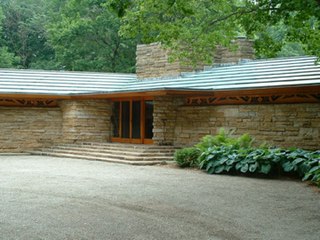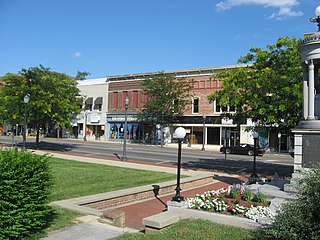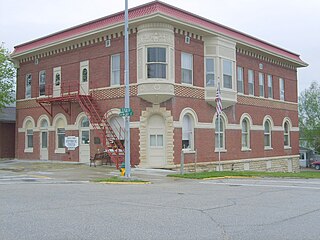
Fayette is a city in and the county seat of Howard County, Missouri, United States. It is part of the Columbia, Missouri Metropolitan Statistical Area. The city's population was 2,803 at the 2020 census.

Central Methodist University is a private university in Fayette, Missouri. CMU is accredited to offer master's, bachelors, and associate degrees. The school is affiliated with the United Methodist Church.

The architecture of Kansas City encompasses the metropolitan area, anchored by Kansas City, Missouri (KCMO). Major buildings by some of the world's most distinguished architects and firms include McKim, Mead and White; Jarvis Hunt; Wight and Wight; Graham, Anderson, Probst and White; Hoit, Price & Barnes; Frank Lloyd Wright; the Office of Mies van der Rohe; Barry Byrne; Edward Larrabee Barnes; Harry Weese; and Skidmore, Owings & Merrill.

Kentuck Knob, also known as the Hagan House, is a house in rural Stewart Township near the village of Chalkhill in Fayette County, Pennsylvania, United States. Designed by the American architect Frank Lloyd Wright, it is 45 miles (72 km) southeast of Pittsburgh. It was designated a National Historic Landmark in 2000 for the quality of its architecture.
Athens is a small unincorporated village in Fayette County to the east of Interstate 75 in Kentucky in the United States.

The Wright Brothers Mule Barn, also known as Rader Packing Co. Bldg. and Diggs Building, is a historic structure built by L.W. and B.C. Wright located at Columbia, Missouri. It is located in an industrial area north of Downtown Columbia, Missouri. The 1+1⁄2-story masonry building was Mid-Missouri's leading mule facility in the 1920s. Today the building has been restored and renovated and offices and lofts.

The Architecture of Buffalo, New York, particularly the buildings constructed between the American Civil War and the Great Depression, is said to have created a new, distinctly American form of architecture and to have influenced design throughout the world.

Washington Court House is a city in Union Township, Fayette County, Ohio. It is the county seat of Fayette County and is located between Cincinnati and Columbus. The population grew almost 1.5% from 2010 to 2020 approaching 14,401 people according to the 2020 census results. The area was initially settled by Virginia veterans of the American Revolution, who received the land from the government as payment for their service in the war.

The B. Harley Bradley House is a Frank Lloyd Wright-designed home, constructed in the Prairie School style, that was constructed in Kankakee, Illinois in 1900–1901.

The Politz Yeshiva and Bais Yaakov, formerly known as Politz Hebrew Academy and the William C. Jacobs School and the Fayette School, is a historic American school that is located in the Bustleton neighborhood of Philadelphia, Pennsylvania.

Mountain Grove is a city in Wright County and Texas County in the U.S. state of Missouri. It lies within the Ozarks in the south-central part of the state. The population was 4,313 at the 2020 census.

Fayetteville Historic District is located in Fayetteville, Texas. The small town of Fayetteville is in rural south east central Texas midway between Houston and Austin. The oldest extant building in the district was constructed in 1853. The historic district represents most of the development within town boundaries as indicated by street signs, the boundaries have been drawn to exclude some areas in town occupied primarily by construction from after 1958. The area of the district is 153.5 acres (62.1 ha) and includes 345 properties considered historical and largely intact. An additional 137 properties within district boundaries are not considered for contribution to the historic status of the district. It was added to the National Register of Historic Places (NRHP) on July 10, 2008.

Dr. Jacob Geiger House-Maud Wyeth Painter House, also known as the United Missouri Bank, is a historic home located at St. Joseph, Missouri. It was designed by the architecture firm of Eckel & Aldrich and built in 1911–1912. It is a 2+1⁄2-story, Gothic Revival style masonry building with a three-story crenellated tower and a two-story crenellated tower. It features an arcaded porch and a four-bay bow window with gargoyles. The house has been converted for commercial uses.

Maple View Sanitarium, also known as Community Hospital, Good Samaritan Nursing Home, and the Fayette County Historical Center, is a historic building located in West Union, Iowa, United States. It was built by Dr. Frank Beach Whitmore in 1903. The facility could accommodate 12 to 15 patients, it had its own operating room, and office. There was also a general store located in the commercial space on the main floor. Because medical care in a hospital was new in the community, it did not succeed and it folded in 1905. Whitmore left to become a missionary in China. The building housed professional offices and retail businesses until 1914 when the Nurses' Benevolent Association under the auspices of the Seventh-day Adventist Church bought the building for a hospital. It was more successful as a hospital the second time, and it was acquired by the city for a community hospital in 1920. After a new hospital building was constructed in 1951, the Good Samaritan Society bought the building for a nursing home. By 1973 changes in state law no longer made operating a nursing home here feasible. The Fayette County Historical Society acquired the building in 1975 for its use, and it operates a local history museum in the building. It was individually listed on the National Register of Historic Places in 1998. In 2015 it was included as a contributing property in the West Union Commercial Historic District.

Springfield Public Square Historic District is a national historic district located at Springfield, Missouri, United States. The district encompasses 27 contributing buildings, 1 contributing site, 1 contributing structure, and 2 contributing objects in Springfield's central business district. The district developed between about 1890 and 1959, and includes representative examples of commercial architecture. Located in the district are the separately listed Franklin Springfield Motor Co. Building, Gillioz Theatre, Heer's Department Store, Netter-Ullman Building, and Marx-Hurlburt Building. Other notable resources include the Landers Building (1915), F. W. Woolworth Co. (1954), J. J. Newberry Co. (1951), S. S. Kresge Co. (1953), Springfield Cigar Company, Stancill Drug Store, National Shirt Co, Salvation Army, Public Square, Queen City Bank (1914), Frisco Office Building (1910), and Cantrell Building.

Fayette Courthouse Square Historic District is a national historic district located at Fayette, Howard County, Missouri. The district encompasses 35 contributing buildings in the central business district of Fayette. It developed between about 1828 and 1947 and includes representative examples of Second Empire, Italianate, and Romanesque Revival style architecture. Located in the district is the separately listed Dr. Uriel S. Wright Office. Other notable buildings include the Fayette Public Library (1914), City Hall (1925), New Opera House Block (1903), A. F. Davis Bank, Commercial Bank (1910), The New Century Block Building (1902), Bell Block Building (1883), U.S. Post Office Building (1925), Howard County Jail and Residence, and Howard County Courthouse (1887).

The Fayette County Courthouse Square Historic District in La Grange, Texas is a historic district roughly bounded by Main, Lafayette, Franklin, Colorado, Jefferson, Washington, and Crockett Streets. It was listed on the National Register of Historic Places on January 16, 2001. Two notable buildings in the district are the Fayette County Courthouse and Jail. Forty–seven buildings, three structures and four objects were identified as contributing to the historic nature of the district.




















